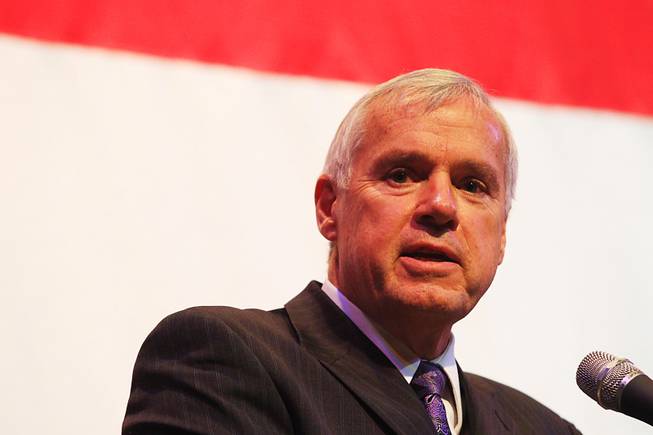
Chancellor Dan Klaich speaks during a town hall style meeting about education Tuesday, Nov. 29, 2011 on the CSN Cheyenne campus.
Friday, April 6, 2012 | 2 a.m.
View more of the Sun's opinion section
For centuries, most societies have placed a high value on education. An educated citizenry is more productive, innovative and leads to an overall improved quality of life for all in the society. As a nation, America has been at the forefront of promoting education and has insisted that it be made available to all citizens. It is this philosophy that created our public education system and is what lies at the heart of how schools are funded.
At the college level, the money we use to educate students, pay faculty and keep the lights on comes from a mix of tuition, grants, research initiatives and state dollars. For many years, the Nevada Legislature has used a rather complicated formula to determine just how much money it would invest in our public higher education system.
As our colleges continued to lead the nation in enrollment growth, that funding formula no longer met the needs of our students or the state. The time had come to change it.
Last year, the Nevada System of Higher Education was asked to propose a new funding model. We reviewed national best practices and created a plan that funds student success rather than the number of students sitting in a classroom. This potential model is based on the following principles:
• The primary driver for allocating state resources will be class instruction as measured by student credit hours and on credit hours for courses completed, a measure of student success.
• Teaching chemistry does not cost the same as teaching English. Differing program costs will be taken into account in determining funding. Also, the research mission of the universities with an additional weighting to upper division and graduate courses will be used to create a pool of dollars to support research activities.
• A base level of support will be given to smaller community colleges to ensure higher education access for all Nevadans.
• Since this model is built on student instruction, the cost of operations and maintenance of physical plants, with the exception of certain research facilities, will be included in the base amount given to each institution as driven by weighted student credit hours.
• Revenue from students’ tuition and fees will remain at their institution
• Additional dollars will be distributed to the institutions based on performance. This performance pool will have metrics that reward institutional behavior that results in student success and grows external financial support from grants and contracts.
Our proposed funding model shifts the emphasis from the public paying for inputs (enrollments) to investing in outputs (course completions and graduating students). The new formula is far simpler, will be easier for all to understand and is based on data that focuses on student success.
This formula is now being reviewed by a legislative committee, and it is our hope that it will be approved and ready to implement for the next budget cycle. We can no longer continue to use a funding model that no longer meets our state’s needs and is counterproductive to student success. By improving the investment process by which Nevada funds its public colleges and universities, we can encourage student success as well as provide a higher return to the citizens who have entrusted us with the development of our next generation of leaders and innovators.
Dan Klaich is the chancellor of the Nevada System of Higher Education.

Join the Discussion:
Check this out for a full explanation of our conversion to the LiveFyre commenting system and instructions on how to sign up for an account.
Full comments policy